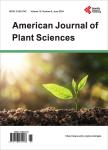Interactions of Auxinic Compounds on Ca2+ Signaling and Root Growth in <i>Arabidopsis thaliana</i>
Interactions of Auxinic Compounds on Ca2+ Signaling and Root Growth in <i>Arabidopsis thaliana</i>作者机构:United States Department of Agriculture-Agricultural Research Service (USDA-ARS) Dale Bumpers National Rice Research Center Stuttgart USA Samuel Roberts Noble Foundation Inc. Ardmore USA United States Department of Agriculture-Agricultural Research Service (USDA-ARS) Crop Production Systems Research Unit Stoneville USA
出 版 物:《American Journal of Plant Sciences》 (美国植物学期刊(英文))
年 卷 期:2015年第6卷第19期
页 面:2989-3000页
学科分类:1002[医学-临床医学] 100214[医学-肿瘤学] 10[医学]
主 题:Auxinic Compound Arabidopsis thaliana Herbicide Calcium Signaling FRET Imaging
摘 要:Auxinic-like compounds have been widely used as weed control agents. Over the years, the modes of action of auxinic herbicides have been elucidated, but most studies thus far have focused on their effects on later stages of plant growth. Here, we show that some select auxins and auxiniclike herbicides trigger a rapid elevation in root cytosolic calcium levels within seconds of application. Arabidopsis thaliana plants expressing the Yellow-Cameleon (YC) 3.60 calcium reporter were treated with indole-3-acetic acid (IAA), indole-3-butyric acid (IBA), 1-naphthalene acetic acid (NAA), and two synthetic herbicides, 2,4-dichlorophenoxyacetic acid (2,4-D) and mecoprop [2-(4-chloro- 2-methylphenoxy) propanoic acid], followed by monitoring cytosolic calcium changes over a 10 minute time course. Seconds after application of compounds to roots, the Ca2+ signaling-mediated pathway was triggered, initiating the plant response to these compounds as monitored and recorded using Fluorescence Resonance Energy Transfer (FRET)-sensitized emission imaging. Each compound elicited a specific and unique cytosolic calcium signature. Also primary root development and elongation was greatly reduced or altered when exposed at two concentrations (0.10 and 1.0 μM) of each compound. Within 20 to 25 min after triggering of the Ca2+ signal, root growth inhibition could be detected. We speculate that differences in calcium signature among the tested auxins and auxinic herbicides might correlate with their variation and potency with regard to root growth inhibition.



